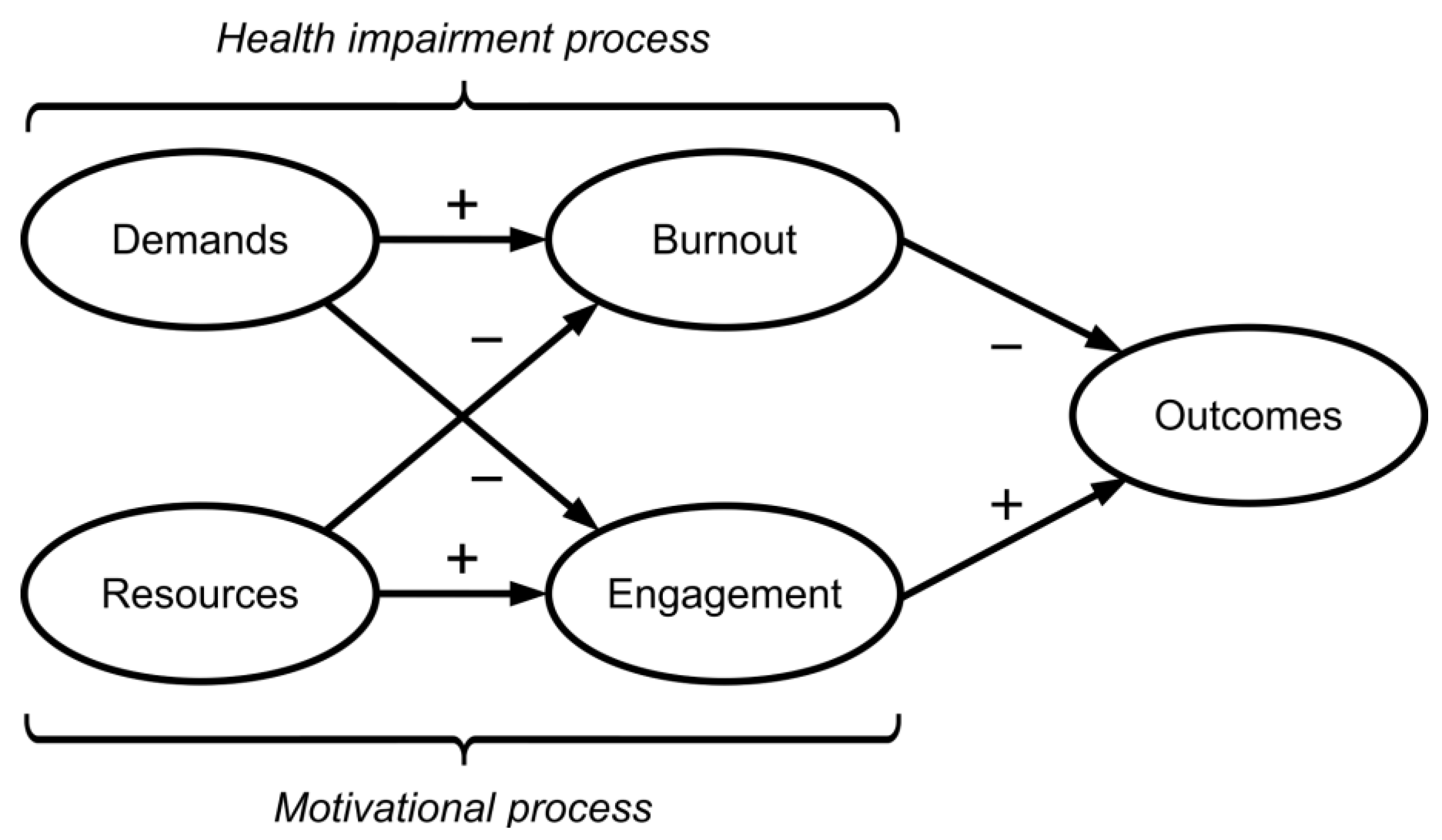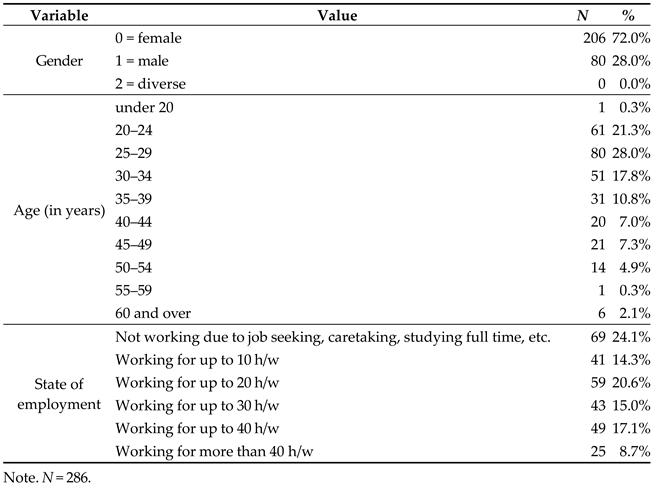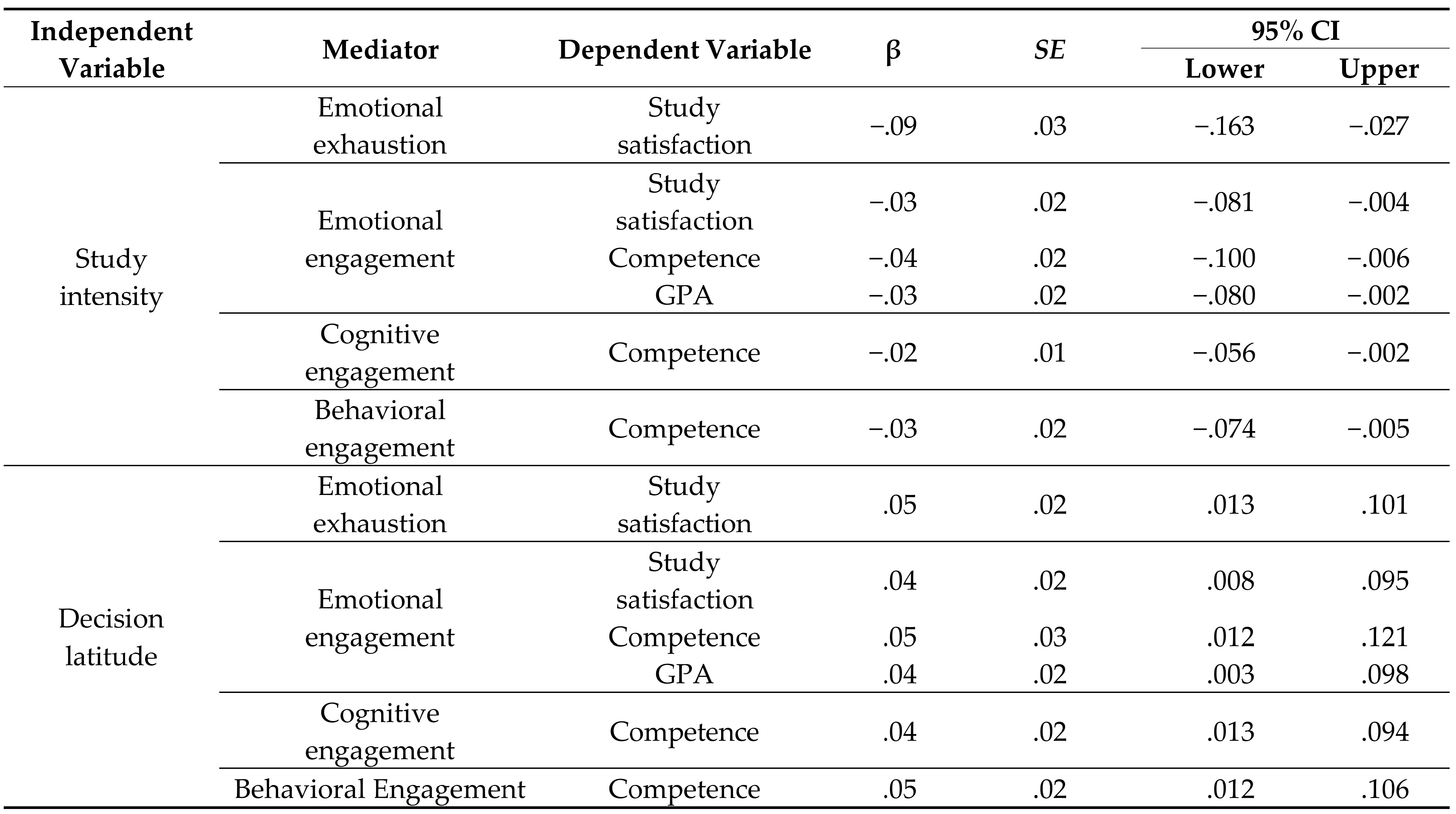Study Demands and Resources in Distance Education—Their Associations with Engagement, Emotional Exhaustion, and Academic Success
Abstract
1. Introduction
1.1. The Job Demands-Resources Model and the Study Demands-Resources Framework
1.2. Study Demands and Resources in Distance Education
2. Materials and Methods
2.1. Sample
2.2. Materials
2.3. Data Analysis
3. Results
4. Discussion
4.1. Emotional Exhaustion, Engagement, and Academic Success
4.2. The Relevance of Study Demands in Distance Education
4.3. The Relevance of Study Resources in Distance Education
4.4. Limitations
4.5. Practical Implications
5. Conclusions
Author Contributions
Funding
Institutional Review Board Statement
Informed Consent Statement
Data Availability Statement
Conflicts of Interest
References
- Akpen, C. N., Asaolu, S., Atobatele, S., Okagbue, H., & Sampson, S. (2024). Impact of online learning on students’ performance and engagement: A systematic review. Discover Education, 3(1), 205. [Google Scholar] [CrossRef]
- Althubaiti, A. (2016). Information bias in health research: Definition, pitfalls, and adjustment methods. Journal of Multidisciplinary Healthcare, 9, 211–217. [Google Scholar] [CrossRef] [PubMed]
- Bakker, A. B., Demerouti, E., & Sanz-Vergel, A. (2023). Job demands–resources theory: Ten years later. Annual Review of Organizational Psychology and Organizational Behavior, 10(1), 25–53. [Google Scholar] [CrossRef]
- Bakker, A. B., & Mostert, K. (2024). Study demands–resources theory: Understanding student well-being in higher education. Educational Psychology Review, 36(3), 92. [Google Scholar] [CrossRef]
- Bakker, A. B., Sanz-Vergel, A. I., & Kuntze, J. (2015). Student engagement and performance: A weekly diary study on the role of openness. Motivation and Emotion, 39(1), 49–62. [Google Scholar] [CrossRef]
- Boerner, S., Seeber, G., Keller, H., & Beinborn, P. (2005). Lernstrategien und Lernerfolg im Studium. Zeitschrift für Entwicklungspsychologie und Pädagogische Psychologie, 37(1), 17–26. [Google Scholar] [CrossRef]
- Borup, J., Graham, C. R., West, R. E., Archambault, L., & Spring, K. J. (2020). Academic communities of engagement: An expansive lens for examining support structures in blended and online learning. Educational Technology Research and Development, 68(2), 807–832. [Google Scholar] [CrossRef]
- Bothma, F., & Monteith, J. L. d. (2004). Self-regulated learning as a prerequisite for successful distance learning. South African Journal of Education, 24(2), 141–147. Available online: https://www.ajol.info/index.php/saje/article/view/24979 (accessed on 18 May 2025).
- Braun, E., Gusy, B., Leidner, B., & Hannover, B. (2008). Das Berliner Evaluationsinstrument für selbsteingeschätzte, studentische Kompetenzen (BEvaKomp). Diagnostica, 54(1), 30–42. [Google Scholar] [CrossRef]
- Chen, K.-C., & Jang, S.-J. (2010). Motivation in online learning: Testing a model of self-determination theory. Computers in Human Behavior, 26(4), 741–752. [Google Scholar] [CrossRef]
- Choi, H. J., & Park, J.-H. (2018). Testing a path-analytic model of adult dropout in online degree programs. Computers & Education, 116, 130–138. [Google Scholar] [CrossRef]
- Choy, S. (2002). Nontraditional undergraduates (NCES 2002–012). National Center for Education Statistics. Available online: https://nces.ed.gov/pubs2002/2002012.pdf (accessed on 18 May 2025).
- Chung, E., Turnbull, D., & Chur-Hansen, A. (2014). Who are “non-traditional students”? A systematic review of published definitions in research on mental health of tertiary students. Educational Research and Reviews, 9(22), 1224–1238. [Google Scholar]
- Cilliers, J. R., Mostert, K., & Nel, J. A. (2018). Study demands, study resources, and the role of personality characteristics in predicting the engagement of fist-year university students. South African Journal of Higher Education, 32(1), 49–70. [Google Scholar] [CrossRef]
- Cohen, S. (2004). Social relationships and health. American Psychologist, 59(8), 676–684. [Google Scholar] [CrossRef]
- Cohen, S., & Wills, T. A. (1985). Stress, social support, and the buffering hypothesis. Psychological Bulletin, 98(2), 310–357. [Google Scholar] [CrossRef]
- Cotton, S. J., Dollard, M. F., & de Jonge, J. (2002). Stress and student job design: Satisfaction, well-being, and performance in university students. International Journal of Stress Management, 9(3), 147–162. [Google Scholar] [CrossRef]
- Damrath, C. (2006). Studienzufriedenheit—Modelle und empirische Befunde. In U. Schmidt (Ed.), Übergänge im Bildungssystem (pp. 227–293). VS Verlag für Sozialwissenschaften. [Google Scholar] [CrossRef]
- Deci, E. L., & Ryan, R. M. (1985). Intrinsic motivation and self-determination in human behavior. Springer. [Google Scholar] [CrossRef]
- Demerouti, E., Bakker, A. B., Nachreiner, F., & Schaufeli, W. B. (2001). The job demands-resources model of burnout. Journal of Applied Psychology, 86(3), 499–512. [Google Scholar] [CrossRef]
- Demerouti, E., Le Blanc, P. M., Bakker, A. B., Schaufeli, W. B., & Hox, J. (2009). Present but sick: A three-wave study on job demands, presenteeism and burnout. Career Development International, 14(1), 50–68. [Google Scholar] [CrossRef]
- Demerouti, E., & Nachreiner, F. (2019). Zum Arbeitsanforderungen-Arbeitsressourcen-Modell von Burnout und Arbeitsengagement–Stand der Forschung. Zeitschrift für Arbeitswissenschaft, 73(2), 119–130. [Google Scholar] [CrossRef]
- Engeser, S., Rheinberg, F., Vollmeyer, R., & Bischoff, J. (2005). Motivation, Flow-Erleben und Lernleistung in universitären Lernsettings. Zeitschrift für Pädagogische Psychologie, 19(3), 159–172. [Google Scholar] [CrossRef]
- Eurostat. (2025). More internet users turn to online learning in 2024. European Union. Available online: https://ec.europa.eu/eurostat/web/products-eurostat-news/w/ddn-20250124-1 (accessed on 18 May 2025).
- Fredricks, J. A., Blumenfeld, P. C., & Paris, A. H. (2004). School engagement: Potential of the concept, state of the evidence. Review of Educational Research, 74(1), 59–109. [Google Scholar] [CrossRef]
- Gagné, M., & Deci, E. L. (2005). Self-determination theory and work motivation. Journal of Organizational Beha-vior, 26(4), 331–362. [Google Scholar] [CrossRef]
- Ghasempour, S., Esmaeeli, M., Abbasi, A., Hosseinzadeh, A., & Ebrahimi, H. (2023). Relationship between academic success, distance education learning environments, and its related factors among medical sciences students: A cross-sectional study. BMC Medical Education, 23(1), 847. [Google Scholar] [CrossRef]
- Gusy, B., Wörfel, F., & Lohmann, K. (2016). Erschöpfung und Engagement im Studium: Eine Anwendung des Job Demands-Resources Modells. Zeitschrift Für Gesundheitspsychologie, 24(1), 41–53. [Google Scholar] [CrossRef]
- Hackman, J. R., & Oldham, G. R. (1975). Development of the job diagnostic survey. Journal of Applied Psychology, 60(2), 159–170. [Google Scholar] [CrossRef]
- Kegel, L. S., Bohndick, C., Breetzke, J., Janke, S., Scheunemann, A., & Wenker, T. (2025). Scale for measuring study satisfaction in higher education. Zusammenstellung sozialwissenschaftlicher Items und Skalen (ZIS). [Google Scholar] [CrossRef]
- Klingsieck, K. B. (2018). Kurz und knapp–die Kurzskala des Fragebogens “Lernstrategien im Studium” (LIST). Zeitschrift für Pädagogische Psychologie, 32(4), 249–259. [Google Scholar] [CrossRef]
- Kohler Giancola, J., Grawitch, M. J., & Borchert, D. (2009). Dealing with the stress of college. Adult Education Quarterly, 59(3), 246–263. [Google Scholar] [CrossRef]
- Lesener, T., Pleiss, L. S., Gusy, B., & Wolter, C. (2020). The Study Demands-Resources Framework: An Empirical Introduction. International Journal of Environmental Research and Public Health, 17(14), 5183. [Google Scholar] [CrossRef]
- MacKinnon, D. P. (2008). Introduction to statistical mediation analysis. Taylor & Francis Group. [Google Scholar] [CrossRef]
- Mokgele, K. R. F., & Rothmann, S. (2014). A structural model of student well-being. South African Journal of Psychology, 44(4), 514–527. [Google Scholar] [CrossRef]
- Muthén, L. K., & Muthén, B. O. (2015). Mplus user’s guide [2008–2015]. Available online: https://www.statmodel.com/html_ug.shtml (accessed on 18 May 2025).
- National Center for Education Statistics. (2023). Undergraduate enrollment. Condition of Education. Available online: https://nces.ed.gov/programs/coe/indicator/cha/undergrad-enrollment (accessed on 18 May 2025).
- Neroni, J., Meijs, C., Gijselaers, H. J., Kirschner, P. A., & de Groot, R. H. (2019). Learning strategies and academic performance in distance education. Learning and Individual Differences, 73, 1–7. [Google Scholar] [CrossRef]
- Neroni, J., Meijs, C., Leontjevas, R., Kirschner, P. A., & de Groot, R. H. (2018). Goal orientation and academic performance in adult distance education. The International Review of Research in Open and Distributed Learning, 19(2). [Google Scholar] [CrossRef]
- Nielsen, I., Newman, A., Smyth, R., Hirst, G., & Heilemann, B. (2016). The influence of instructor support, family support and psychological capital on the well-being of postgraduate students: A moderated mediation model. Studies in Higher Education, 42(11), 2099–2115. [Google Scholar] [CrossRef]
- Ouweneel, E., Le Blanc, P. M., & Schaufeli, W. B. (2011). Flourishing students: A longitudinal study on positive emotions, personal resources, and study engagement. The Journal of Positive Psychology, 6(2), 142–153. [Google Scholar] [CrossRef]
- Reis, D., Xanthopoulou, D., & Tsaousis, I. (2015). Measuring job and academic burnout with the Oldenburg Burnout Inventory (OLBI): Factorial invariance across samples and countries. Burnout Research, 2(1), 8–18. [Google Scholar] [CrossRef]
- Rheinberg, F., Vollmeyer, R., & Engeser, S. (2003). Die Erfassung des Flow-Erlebens. In J. Stiensmeier-Pelster, & F. Rheinberg (Eds.), Diagnostik von Selbstkonzept, Lernmotivation und Selbstregulation (pp. 261–280). Hogrefe. [Google Scholar]
- Richter, P., Hemmann, E., Merboth, H., Fritz, S., Hansgen, C., & Rudolf, M. (2000). Das Erleben von Arbeitsintensität und Tätigkeitsspielraum-Entwicklung und Validierung eines Fragebogens zur orientierenden Analyse (FIT). Zeitschrift für Arbeits-Und Organisationspsychologie A&O, 44(3), 129–139. [Google Scholar] [CrossRef]
- Rindermann, H., & Oubaid, V. (1999). Auswahl von Studienanfängern durch Universitäten-Kriterien, Verfahren und Prognostizierbarkeit des Studienerfolgs. Zeitschrift für Differentielle und Diagnostische Psychologie, 20(3), 172–191. [Google Scholar] [CrossRef]
- Robins, T. G., Roberts, R. M., & Sarris, A. (2015). Burnout and engagement in health profession students: The relationships between study demands, study resources and personal resources. Australasian Journal of Organisational Psychology, 8, e1. [Google Scholar] [CrossRef]
- Schaeper, H., & Weiß, T. (2016). The Conceptualization, Development, and Validation of an Instrument for Measuring the Formal Learning Environment in Higher Education. In H.-P. Blossfeld, J. von Maurice, M. Bayer, & J. Skopek (Eds.), Methodological Issues of Longitudinal Surveys (pp. 267–290). Springer VS. [Google Scholar] [CrossRef]
- Schaufeli, W. B., Martínez, I. M., Pinto, A. M., Salanova, M., & Bakker, A. B. (2002). Utrecht work engagement scale for students (UWES-S, UWES-SF) [Database record]. APA PsycTests. [Google Scholar] [CrossRef]
- Schiefele, U., & Jacob-Ebbinghaus, L. (2006). Lernermerkmale und Lehrqualität als Be-dingungen der Studienzufriedenheit [Student characteristics and perceived teaching quality as conditions of study satisfaction]. Zeitschrift für Pädagogische Psychologie, 20(3), 199–212. [Google Scholar] [CrossRef]
- Schmidt, L. I., Scheiter, F., Neubauer, A., & Sieverding, M. (2019). Anforderungen, Entscheidungsfreiräume und Stress im Studium. Diagnostica, 65(2), 63–74. [Google Scholar] [CrossRef]
- Schneider, M., & Preckel, F. (2017). Variables associated with achievement in higher education: A systematic review of meta-analyses. Psychological Bulletin, 143(6), 565–600. [Google Scholar] [CrossRef] [PubMed]
- Sieverding, M., Schmidt, L. I., Obergfell, J., & Scheiter, F. (2013). Stress und Studienzufriedenheit bei Bachelor-und Diplom-Psychologiestudierenden im Vergleich. Psychologische Rundschau, 64(2), 94–100. [Google Scholar] [CrossRef]
- Speyer, L. G., Ushakova, A., Blakemore, S.-J., Murray, A. L., & Kievit, R. (2023). Testing for within × within and between × within moderation using random intercept cross-lagged panel models. Structural Equation Modeling: A Multidisciplinary Journal, 30(2), 315–327. [Google Scholar] [CrossRef]
- Stoessel, K., Ihme, T. A., Barbarino, M.-L., Fisseler, B., & Stürmer, S. (2015). Sociodemographic diversity and distance education: Who drops out from academic programs and why? Research in Higher Education, 56(3), 228–246. [Google Scholar] [CrossRef]
- Stürmer, S., Christ, O., Jonkmann, K., Josephs, I., Gaschler, R., Andreas, G., Mokros, A., Rohmann, A., & Salewski, C. (2018). 10 Jahre universitäres Fernstudium in Psychologie an der FernUniversität in Hagen. Psychologische Rundschau, 69(2), 104–108. [Google Scholar] [CrossRef]
- Tho, N. D. (2023). Business students’ psychological capital and quality of university life: The moderating role of study crafting. Journal of Education and Training, 65(1), 163–177. [Google Scholar] [CrossRef]
- Warr, P. (2009). Environmental “vitamins”, personal judgments, work values, and happiness. In S. Cartwright, & C. L. Cooper (Eds.), The Oxford handbook of organizational well being (pp. 57–85). Oxford University Press. [Google Scholar] [CrossRef]
- Westermann, R., Elke, H., Spies, K., & Trautwein, U. (1996). Identifikation und Erfassung von Komponenten der Studienzufriedenheit [Identifying and assessing components of student satisfaction]. Psychologie in Erziehung und Unterricht, 43(1), 1–22. [Google Scholar]
- Wild, K. P., & Schiefele, U. (1994). Lernstrategien im Studium: Ergebnisse zur Faktorenstruktur und Reliabilität eines neuen Fragebogens. Zeitschrift für Differentielle und Diagnostische Psychologie, 15(4), 185–200. Available online: https://nbn-resolving.org/urn:nbn:de:kobv:517-opus-33638 (accessed on 18 May 2025).
- Wolter, A. (2012). Germany: From individual talent to institutional permeability: Changing policies for non-traditional access routes in German higher education. In M. Slowey, & H. G. Schuetze (Eds.), Global perspectives on higher education and lifelong learners: International perspectives (pp. 43–59). Routledge. [Google Scholar]
- Xanthopoulou, D., Bakker, A. B., Demerouti, E., & Schaufeli, W. B. (2009). Reciprocal relationships between job resources, personal resources, and work engagement. Journal of Vocational Behavior, 74, 235–244. [Google Scholar] [CrossRef]


 |
| Scales | M | SD | α | Range | Items | Example Items | Source |
|---|---|---|---|---|---|---|---|
| Study intensity | 2.7 | 0.6 | 0.86 | 1–4 | 6 | My distance learning requires a lot of effort from me. | Richter et al. (2000) |
| Decision latitude | 2.8 | 0.5 | 0.63 | 1–4 | 6 | I can organize and schedule my distance learning on my own. | Richter et al. (2000) |
| Support from lecturers | 4.0 | 1.2 | 0.93 | 1–6 | 3 | The lecturers are cooperative and open-minded. | Schaeper and Weiß (2016) |
| Support from peers | 4.2 | 1.0 | 0.80 | 1–6 | 3 | In general, students support each other. | Schaeper and Weiß (2016) |
| Emotional exhaustion | 2.4 | 0.6 | 0.83 | 1–4 | 8 | There are days when I feel dull even before I start with my study tasks. | Reis et al. (2015) |
| Emotional engagement | 3.9 | 1.0 | 0.87 | 1–7 | 10 | I am completely absorbed in what I am doing. | Rheinberg et al. (2003) |
| Cognitive engagement | 3.5 | 0.7 | 0.72 | 1–5 | 6 | I ask myself questions about the material to check whether I have understood everything. | Klingsieck (2018) |
| Behavioral Engagement | 4.1 | 0.7 | 0.67 | 1–5 | 3 | I don’t give up, even if the subject matter is difficult or complex. | Klingsieck (2018) |
| Competence | 3.4 | 0.8 | 0.85 | 1–5 | 6 | I can reproduce important terms/concepts of my distance learning so far. | Braun et al. (2008) |
| Study satisfaction | 7.0 | 1.90 | - | 1–10 | 1 | Overall, I am satisfied with my studies. | Self-constructed |
| Variable | Value | N | % |
|---|---|---|---|
| GPA | 6 = 1.0–1.5 (best) | 12 | 4.2% |
| 5 = 1.6–2.0 | 49 | 17.3% | |
| 4 = 2.1–2.5 | 80 | 28.3% | |
| 3 = 2.6–3.0 | 69 | 24.4% | |
| 2 = 3.1–3.5 | 58 | 20.5% | |
| 1 = 3.6–4.0 (worst) | 15 | 5.3% |
 |
 |
 |
Disclaimer/Publisher’s Note: The statements, opinions and data contained in all publications are solely those of the individual author(s) and contributor(s) and not of MDPI and/or the editor(s). MDPI and/or the editor(s) disclaim responsibility for any injury to people or property resulting from any ideas, methods, instructions or products referred to in the content. |
© 2025 by the authors. Licensee MDPI, Basel, Switzerland. This article is an open access article distributed under the terms and conditions of the Creative Commons Attribution (CC BY) license (https://creativecommons.org/licenses/by/4.0/).
Share and Cite
Pumpe, I.E.; Jonkmann, K. Study Demands and Resources in Distance Education—Their Associations with Engagement, Emotional Exhaustion, and Academic Success. Educ. Sci. 2025, 15, 664. https://doi.org/10.3390/educsci15060664
Pumpe IE, Jonkmann K. Study Demands and Resources in Distance Education—Their Associations with Engagement, Emotional Exhaustion, and Academic Success. Education Sciences. 2025; 15(6):664. https://doi.org/10.3390/educsci15060664
Chicago/Turabian StylePumpe, Ina E., and Kathrin Jonkmann. 2025. "Study Demands and Resources in Distance Education—Their Associations with Engagement, Emotional Exhaustion, and Academic Success" Education Sciences 15, no. 6: 664. https://doi.org/10.3390/educsci15060664
APA StylePumpe, I. E., & Jonkmann, K. (2025). Study Demands and Resources in Distance Education—Their Associations with Engagement, Emotional Exhaustion, and Academic Success. Education Sciences, 15(6), 664. https://doi.org/10.3390/educsci15060664







